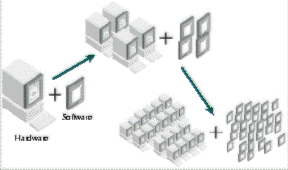
In a speech to the 1997 National Educational Computing Conference held in Seattle, Bill Gates discussed the circular relationship that exists between software and hardware sales. Essentially, software drives the sales of hardware and hardware drives the sales of software. The hardware-software sales cycle is shown in Figure 6-2.
You’ll invest heavily in servers.
FIGURE 6-2
The hardware and software sales cycle

Networked computing environment issues present a variation on the theme presented in Gates’s keynote. In most cases, you buy software to work with your current hardware or you buy hardware that will work with your legacy software. Upgrading an entire company to 32-bit Windows-based applications could mean upgrading the hardware at every workstation, an expense that could prevent you from using a great new software product. In the long term, you might be better off spending $25,000 to purchase a heavy-duty server with Pentium Pro 200-MHz processors that can comfortably support 40 users with thin-client/server software. Otherwise, if you purchase new equipment for 40 users’ desktops, at a cost of about $2,500 per workstation for computers with the latest processor, you would be spending $100,000 or more. The cost difference between purchasing a server for a thin-client/server scenario and purchasing 40 PCs comes to about $75,000. You could use a portion of the savings to purchase Windows-based terminals, or you could opt for the NetPC platform. You could upgrade old PCs to a minimum of 2 MB of RAM and with displays and adapters capable of VGA or better. Or you could pay for the services of a planner/integrator who is conversant with installation of a thin-client/server environment. Using the thin-client/server scenario, you could deploy the latest 32-bit software for Windows, client/server applications, or any applications with a thin-client/server protocol (such as ICA) to almost any device existing on your network. (Consult the “Hardware and Software Requirements” section later in this chapter for more specific information about the type of server that is needed for a thin-client/server environment.)
If a savvy administrator was taking advantage of volume software license purchases, software costs for a thin-client/server solution would be similar to the costs of software licenses for every workstation, with the exception of licensing that permitted concur-rency. In that case, you might think in terms of peak usage rather than number of desktops.
Using the thin-client/server architecture, you’ll be better able to take advantage of volume licensing programs that offer concurrency.
In short, deployment of a thin-client/server computing infrastructure allows for reallocation and optimization of funds and resources. If you use the ICA protocol, you’ll make very efficient use of your system’s available bandwidth. Further, ICA allows you to leverage existing hardware and offers inexpensive alternatives for new hardware.